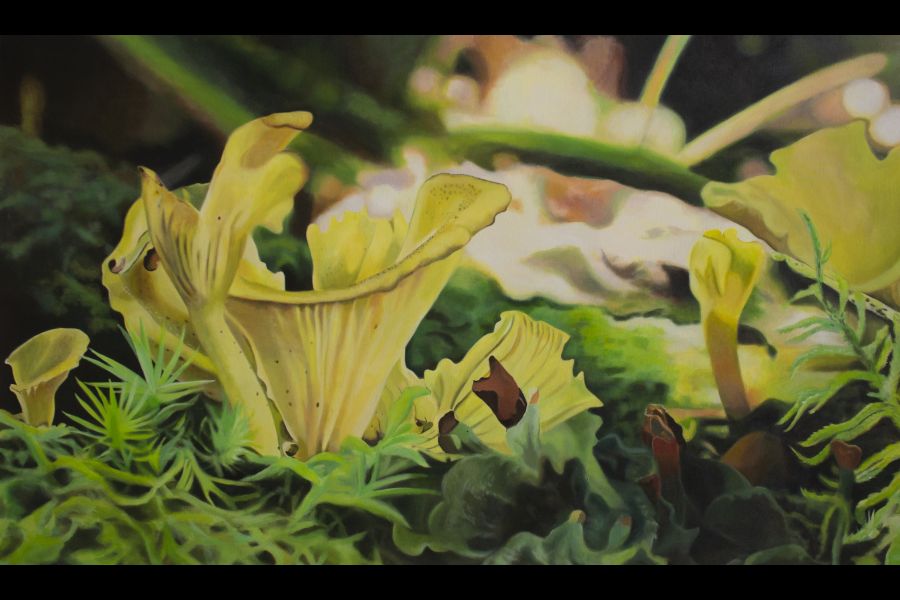Debra Antoncic
Special to The Lake Report/Niagara Now
A new exhibition at RiverBrink Art Museum transports the viewer into the mysterious and seemingly alien world of lichens.
In this series of paintings on display in the main floor galleries, Niagara artist Melanie MacDonald captures the extraordinary diversity and magic of these composite organisms.
The experience is similar to stepping into a tropical garden, the warm colours and intricate patterns of nature a welcome respite, particularly during a Canadian winter.
Lichens are highly complex organisms comprised of fungi and microscopic algae living in symbiosis. They are ubiquitous, found on bark, rocks, on walls, in woodlands, deserts, or tundra.
In this series of paintings, they appear in fairylike clusters of coralline branches, tiny cups or leaflike fronds. They resemble plants or fungi, are both tenacious yet fragile, and represent the co-dependence and interconnectedness of the natural world.
These natural visual qualities have drawn many artists to focus on lichens, particularly those artists interested in the close study of nature.
Victorian-era art critic and writer John Ruskin (1819-1900) wrote extensively on lichens, and captured their beauty and variety in numerous watercolours, his interest closely tied to botany and nature studies of the smallest, most insignificant organisms.
Others, such as Saskatchewan artist Ernest Lindner ((1897-1988), came to the subject of lichens and forest vegetation from a tradition of landscape painting. More recently, artists have taken lichens as the starting point for immersive installations and large-scale photographic work.
MacDonald’s paintings of lichens, in contrast, are more closely aligned with her previous explorations in the genre of still life.
The delicate fronds and branches of these living organisms, rendered in closeup, recall series such as In the Kitchen (2008-18) and Board Games (2009-20), in which MacDonald captures everyday objects with exacting detail.
Just as vintage flea-market treasures and mass-produced kitsch are rendered in a photo-realist style, individual lichens have been isolated and magnified.
Working with photography, using a macro lens and additional exploration and framing on a computer, MacDonald is able to pull details into focus. Highly intricate and complex in the foreground, the lichens are set against a background of blurred shapes awash in colour.
The green-browns and blacks of Untitled (Chanterelles Mushrooms and Pelt Lichen) 2021 are broken by a burst of yellow, the vibrant colour astonishing. In other paintings, such as Untitled (Monk’s Hood Lichen and Beard Lichen) 2021, it is the details of the delicate tracery that capture attention.
The colours are lush, vibrant and unexpected, the shapes and textures otherworldly. Under this magnification, we might mistake these as abstract forms, rather than representations of living organisms.
Although lichens are the focus of intense scientific study, MacDonald, who is based in St. Catharines, has approached the subject from the perspective of a nonscientist, a common practice in the field of lichens research and identification.
In this body of work, MacDonald draws attention to the aesthetics of surfaces and textures and colour, to details that cannot be seen with the naked eye. In so doing, she shares both her acquired knowledge and her appreciation of lichens.
In these highly detailed renderings is a world that is both strange and beautiful and, ultimately, very fragile. At least since the mid-19th century the sensitivity of lichens to air pollution has made them harbingers of environmental damage.
They also perform important ecological functions, such as soil stabilization. Yet they are often overlooked, fading into the background, or disappearing into the undergrowth of a forest.
With this series, MacDonald redirects our gaze, forcing us to pay attention, to take greater notice of the world around us.
Debra Antoncic is RiverBrink's director and curator.










